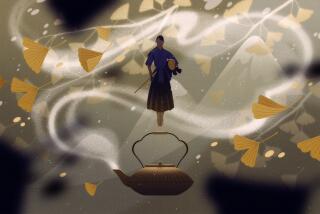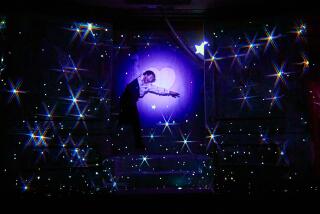Yoko Ono’s ‘Acorn’ delivers its messages concisely
- Share via
For a small book, Yoko Ono’s new collection of instructions, “Acorn” (O/R Books: 216 pp., $16 paper), has been in the works for a long time: almost half a century.
“It’s been nearly 50 years since my book of conceptual instructions, ‘Grapefruit,’ was first published,” the 80-year-old avant-garde icon writes in a brief introduction to the project. “Some years ago, I picked up from where I left off, and wrote ‘Acorn’ for a website event. Now it’s being published in book form. I’m riding a time machine that’s going back to the old ways!”
“Grapefruit” remains among the unsung artworks of the 1960s, an encapsulation of Ono’s aesthetic in the form of aphorisms. Originally released in 1964, it predates her relationship with John Lennon, suggesting just how much the former Beatle learned from her: a sense of openness, of the universe as inherently creative, even positive, if only we imagine it as such.
“Nature itself is very positive,” Ono insists on a recent weekday morning by phone from her New York office. “When things are not positive, they die.”
This was the essential intent of “Grapefruit,” as it is of “Acorn,” which gathers 100 brief thought experiments (“Find a spot that is comfortable for you. / Keep the spot clean. / Think about the spot when you are away,” reads “City Piece I” in its entirety), each accompanied by pointillist “dot drawings,” that in their own ways offer a guide to simplifying the challenges of a complex world.
“I realized,” Ono says, “that I didn’t have to make a long speech. A message can be sent in one or two words. That makes ‘Acorn’ — like ‘Grapefruit’ — different from a normal book. It’s easy to read and get the message of the universe. Maybe in the future, books will be like that: brief messages we send each other.”
For Ono, the issue of books, and how we interact with them, is a core concern. “Reading,” she explains, her voice a murmured susurration, “is very important to me. People are used to computers, but I’m used to reading books.” And yet, she acknowledges, we live in an age when many people find it difficult to engage with the printed word.
“We read one page, one chapter,” Ono says, “and our brains can’t go any further. It’s happening to all of us.”
In that sense, perhaps, “Acorn” — which she developed in 1996 as an early digital experiment and subsequently reprised as a series of blog posts, one per day for 100 days, in 2008 — is meant as an alternative, “in between reading and the Internet.” The key, she continues, is engagement, whether through the medium of the page, the screen or, more important, the world.
Indeed, “Acorn” has its roots in just such a global effort, a 1969 conceptual work in which Ono and Lennon planted two acorns for peace at England’s Coventry Cathedral, then mailed additional acorns to a variety of world leaders with a letter reading, “Enclosed in this package we are sending you two living sculptures — which are acorns — in the hope that you will plant them in your garden and grow two oak-trees for world peace.”
Lennon wrote about the acorns in the Beatles song “The Ballad of John and Yoko,” but in many ways, it was more her project than his. Its attitude of pointed whimsy has been a hallmark of Ono’s sensibility going back to the start of her career. In the early 1960s, she worked with the Fluxus Group in New York; one of her most notorious performances dates from this period: “Cut Piece,” in which an audience cut away her clothing piece by piece.
Ono has always balanced playfulness with confrontation, as a way to provoke us out of our complacency — an intention “Cut Piece” embodies at the core. The same might be said of “Acorn,” whose entries come loaded with the recognition that life, positive though it may be, can’t help but cut two ways.
“Swim as far as you can in your dream,” she writes in “Connection Piece VI.” “Away from: / your home / your mate / your children / your pets / your belongings / your work place / your colleagues // See if you drown or survive.”
It’s hard not to read some of Ono’s experience into that instruction, with its clear-eyed acceptance of isolation — not of how, but whether, we survive. At the same time, she suggests, what’s salient is not the loss so much as the awareness, the direct interaction with the moment, with the process of being alive.
“I’m not looking for anything,” Ono says. “I am always in a certain kind of place that gives me inspiration. Or maybe patience is a better way of saying it.” Patience, yes. Or participation, another favorite word.
“Write down a sad memory,” she urges in “Cleaning Piece I.” “Put it in a box. / Burn the box and sprinkle the ashes in the field. / You may give some ashes / to a friend who shared the sadness.”
More to Read
Sign up for our Book Club newsletter
Get the latest news, events and more from the Los Angeles Times Book Club, and help us get L.A. reading and talking.
You may occasionally receive promotional content from the Los Angeles Times.








